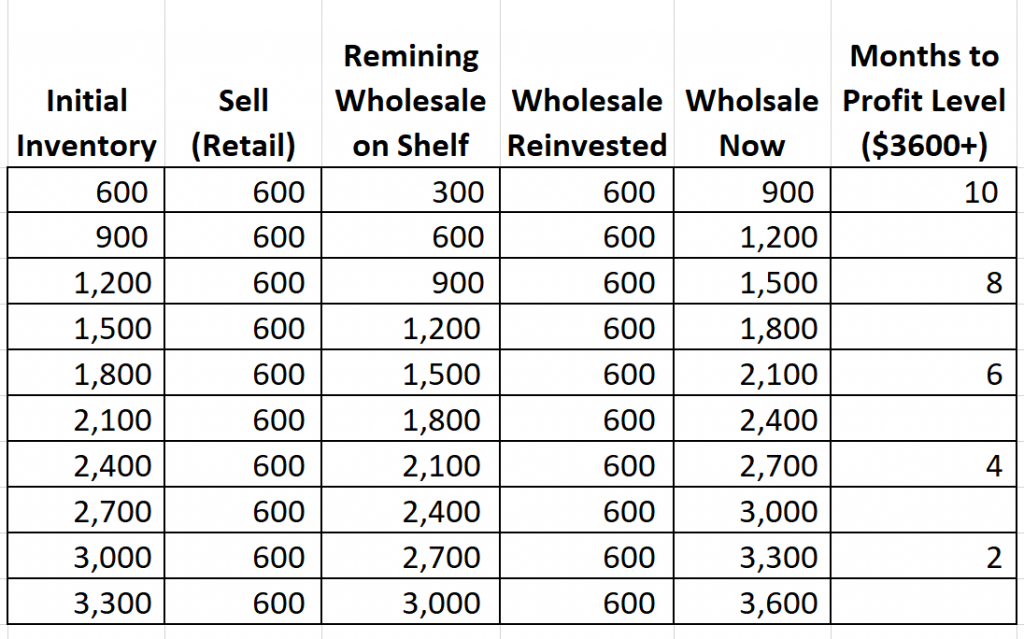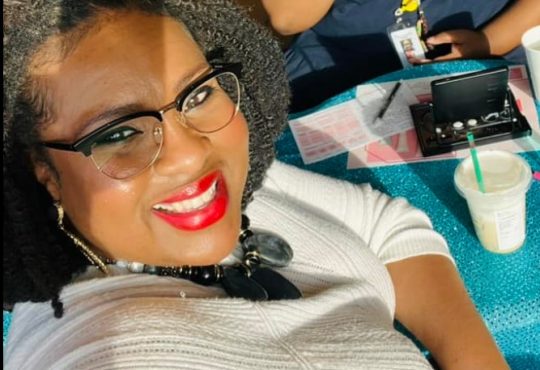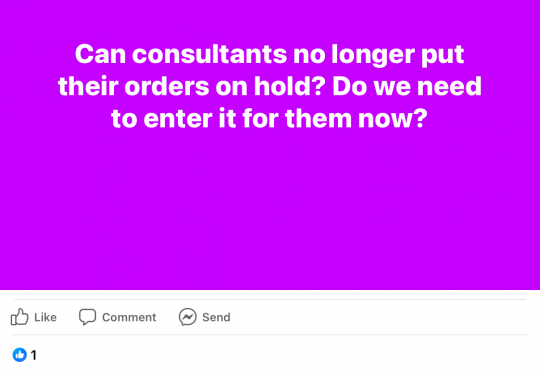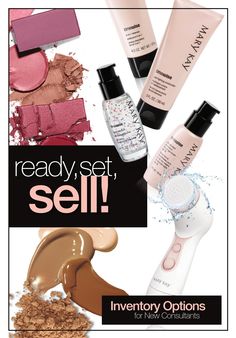Profit Level Inventory in Mary Kay
 You’ve heard this Mary Kay lie many times before: $3,600 wholesale on your shelf is considered “profit level” inventory, and until you get to that level, you shouldn’t be taking any profits for yourself out of your “business.”
You’ve heard this Mary Kay lie many times before: $3,600 wholesale on your shelf is considered “profit level” inventory, and until you get to that level, you shouldn’t be taking any profits for yourself out of your “business.”
Realistically speaking, there is very little profit in Mary Kay to begin with. But this “concept” twists the financial aspect even further and uses faulty logic and bad math to convince consultants to place large initial orders.
Here’s how the Mary Kay explanation goes:
Please study this chart prior to sharing inventory with your new consultant. Study how long it takes to get to profit level.
Begin with 600 wholesale – Need to place 10 months of 600s to arrive at minimum of 3600. Reinvesting before making a profit.
Begin with 1200 wholesale – Must place 8 months of 600s to equal 3600.
Begin with 2400 wholesale – Must place 6 month of 600s to equal 3600.
Begin with 3000 wholesale – Must place 2 month of 600s to equal 3600.
Are you being fair to your new recruit by bringing her in with less than 3600? Look at what profit could have been made.! Ask yourself this question…Would “I” have rather made 3000 during those 10 months or reinvested and had no profit to apply to my families’ budget or to debt reduction?. Which way would produce a happy excited powerful consultant? Which consultant (600 or 3600) would more than likely be still involved with MK even 6 months down the road? Choose to operate from your power and leadership and guide her to invest profit level!

Here’s the real truth:
There is no need to get your inventory to some magical “profit level” number before you’re entitled to take a “profit” out of your Mary Kay business. That’s the first problem with all of this.
The second problem is that $3,600 wholesale on the shelf is completely unnecessary. It is just tying up money and it’s unneeded. Further, as a new consultant, you should NOT be ordering this much. You don’t know if you can even sell any product, and you have no idea what you’ll sell. Ordering this much to start is one of the worst things you can do.
This document is just a deceptive tool to get consultants to order far more than they should. It’s set up to make you think that you need this much inventory to be “successful.” You don’t. This much inventory actually works against you.
By the way, $3,600 wholesale is the exact same number as it was over 20 years ago when I was in MK. This proves that MK ladies have no money sense at all. $3,600 buys much less than it did 20 years ago, but they don’t update their “business” model. If a certain amount of inventory was reasonable or necessary, that amount would probably change over time. Since it’s a completely fictional number pulled out of thin air, and only determined by how much directors want their commission checks to be, it never changes.





 Visit the
Visit the
Has anyone noticed how MK packs the inventory boxes ? 10-20 years ago the boxes were about a 2×3 ish size packed with product and peanuts . You would order a 600 level and get about 5-8 big boxes .
Now everything is puzzled pieced in with no peanuts and boxes are small like 2×2.
They will pack a 600 into one box and most of the time (if cosmetics) a $1000 wholesale on one small box .
It makes it APPEAR like less. Especially to those unsuspecting husbands.
It also appears less to a new consultant so she thinks it’s not so much.
That might be for the environment?
Anyone who understands the retail business knows how carrying excess inventory is really bad for the bottom line. Mary Kay pretends inventory is “your ATM,” but in reality inventory Is capital that’s tied up. Inventory must be carefully managed to match sales, not run up to some arbitrary dollar amount of items you don’t know will sell at all.
Calling $3,600 tied up in inventory a “profit level” verges on violating the FTC Act (inventory is NOT profit!). And what a coincidence: the FTC recently issued a written warning to hundreds of MLMs against making false income claims. Here is a link to their 10/26/2021 press release:
https://www.ftc.gov/news-events/press-releases/2021/10/ftc-puts-businesses-notice-false-money-making-claims-could-lead
Exactly! And here’s another bit of “Mary Kay Math” that should be an easy target for the FTC since almost every director does it and posts about it on social media:
My wholesale purchases + double credit x 2 = LOOKIT HOW MUCH I’VE SOLD YAY
I AM A MARY KAY MILL-YUN-AIR!
I have worked for companies that really understood “profit level inventory”. And it is “as little as possible without losing too many customers or losing too much on shipping costs”. Typically they carried enough of the products that made up most of the sales to handle a month’s worth of sales and special ordered the rest.
More proof of the fact that Mary Kay is a barely legal pyramid scheme. In order to comply with laws against pyramid schemes, there has to be a policy that consultants shouldn’t buy more until they’ve sold at least 70% of what they have on hand. So if leadership wasn’t sharing that kind of crap and was doing things the “right way”, a consultant who ordered $3600 wholesale would have to sell at least $2520 of it before ordering again. Of course, no one cares. The first order is the biggest anyone will do (unless they’re trying to finish DIQ, a car, a national area, or save their unit, so pushing for the most is the only way to make any money. Pyramid. Scheme.
The “must sell 70% before reordering law” is a myth. There was a precedent set in the Amway case in 1979, where the administrative law judge ruled that Amway’s program requirements made it NOT a pyramid scheme. The first two findings of the judge (emphasis added):
1. Amway required its representatives to engage in retail selling, under the “ten retail customer policy” which appeared in the agreement that representatives signed upon enrollment. This rule required that representatives make 10 sales to retail customers as a qualification for eligibility to receive commissions and bonuses on sales/purchases made by other representatives in their personal sales organization.
2. Amway required its representatives to sell a minimum of 70% of previously purchased product before placing a new order. (Amway’s rules recognize “personal use” for purposes of the 70% rule.)
[The third finding related to the buy-back program.]
The fact that Amway’s agreement used the 70% figure didn’t make it a law per se, but it did give other companies a framework to copy to keep the FTC out of their hair.
THERE ARE TWO BIG PROBLEMS WITH THE ADMINISTRATIVE LAW JUDGE’S FINDINGS.
First and foremost, Amway provided no evidence that they enforced the 10-retail-sales rule. They included a sheet of paper in the starter kit for the signee to list sales completed, but there was zero follow-up by Amway. In fact, by the early 80’s, uplines made sure to be there at the box opening to snatch that sheet away and wad it up, saying, “That’s the old Amway.” (Source: http://www.transgallaxys.com/~emerald/files/MerchantsOfDeception.pdf )
The 70% rule was equally pointless, because a) Amway didn’t enforce it, and b) personal use counted as selling. Heck, personal use could easily be throwing it in the garbage or storing it in the basement. That’s not selling.
In my opinion, the administrative law judge was either bought off or grossly incompetent. Or I suppose the FTC might have presented a weak case.
Anyway, that’s the source of the phantom FTC law about 70% that isn’t actually on any books anywhere.
Oh my. I’m reading the book you linked here. I’m up to page 84. This is quite the rabbit hole. Just by searching a few names and terms, I discovered that there’s an “Amway wiki”. If anyone needs me, just shine a flashlight down this hole lol!
“Would “I” have rather made 3000 during those 10 months or reinvested and had no profit to apply to my families’ budget?”
Oh lady, whoever you are…you never “made” $3000 over 10 months. And that’s NET profit. Nope, never happened, but you’ll use it for a story to tell your recruits.